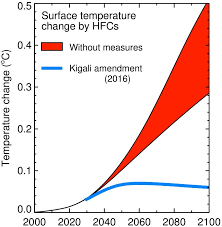Why in news?
India has decided to ratify the Kigali Amendment to the Montreal Protocol.
What is the Montreal Protocol (1989)?
It is an international treaty that regulates the production and consumption of nearly 100 man-made chemicals referred to as ozone depleting substances (ODS).
The ODS, when released to the atmosphere, damage the ‘stratospheric ozone layer’ that protects the earth against the harmful levels of UV radiation from the sun.
It mandated the complete phase-out of chlorofluorocarbons or CFCs and other ODS.
CFCs are a set of chemicals mainly used in the air-conditioning and refrigeration industry earlier.
Extensive use led to depletion of the ozone layer, and formation of an “ozone hole” over the Antarctic region.
CFCs were gradually replaced, first by hydrochlorofluorocarbons (HCFCs).
Eventually, hydrofluorocarbons (HFCs) were introduced as non-ozone depleting alternatives to support the timely phase out of CFCs and HCFCs.
What was the problem with HFCs?
HFCs do not deplete the ozone but are powerful greenhouse gases (GHGs) with high Global Warming Potential (GWP).
It is essential to phase out HFCs as-
Global warming is emerging as one of the biggest global challenges.
Air-conditioning demand is showing a significant increase, especially in countries like India.
The average GWP of 22 of the most used HFCs is about 2,500 times that of CO2. If left unabated, HFCs might contribute to annual GHG emissions up to 19% by 2050.
So, what is the Kigali amendment?
The Montreal Protocol was amended in 2016 (9th time) after negotiations in Kigali, the capital of Rwanda.
It essentially enables the gradual phase-down of hydrofluorocarbons, or HFCs.
The terms entered into force in 2019, and have been signed by more than 122 countries so far.
Group I: Rich & developed economies like USA and EU; Started phase down HFCs by 2019 and reduce it to 15% of 2012 levels by 2036
Group II: Emerging economies like China, Brazil start phase down by 2024 and reduce it to 20% of 2021 levels by 2045.
Group III: Developing economies and some of the hottest climatic countries like India, Pakistan, Iran, Saudi Arabia starts phasing down by 2028 and reduce it to 15% of 2024-2026 levels till 2047.
HFCs reduction as per the countries’commitments is estimated to reduce Earth’s average surface warming by 0.5ºC over pre-industrial era levels.
Why HFC is under the Montreal protocol if it is not an ODS?
Being non-ozone-depleting, HFCs reduction was under the 1997 Kyoto Protocol and 2015 Paris Agreement that addressed GHG emissions and climate change.
But the Montreal Protocol has –
far more effective and successful than the climate change instruments
already resulted in the phase-out of 98.6% of ODS.
to date, the only UN treaty ever that has been ratified by every country - all 198 UN Member States
So, it was decided to use the Montreal Protocol to phase out HFCs.

How is India’s performance?
According to Climate Action Tracker, India is one of the few countries whose actions are compatible with keeping warming below 2ºC.
The climate actions of different countries are rated as below:
Australia, Brazil, Canada, the UK and all of Europe - ‘Insufficient’
China, Japan and South Africa - ‘Highly insufficient’
Argentina, Russia, Saudi Arabia and Turkey - ‘Critically insufficient’
India recently crossed the milestone of 100 GW of installed renewable energy capacity.
India will also draw up a national strategy for phase-down of HFCs by the year 2023 in ‘consultation with all industry stakeholders.’
Amendments to the Ozone Depleting Substances (Regulation and Control) Rules will be done by mid-2024.
Also read about - ‘India Cooling Action Plan’
What are the concerns?
Overall energy policy pushes for both renewable and fossil-fuel-based energy production.
E.g., Draft National Electricity Policy 2021 said India would build more coal power plants given its cost-effectiveness.
Centre’s attempts to allow violators to ‘pay and pollute’ undermines the other efforts.
Fossil fuel producers, mostly from Russia, US and the Middle East, have begun entering India, seeing it as one of the last big markets for fossil fuels.
These realities suggest that India’s energy transition will see a delay.
Source: The Indian Express, The Wire